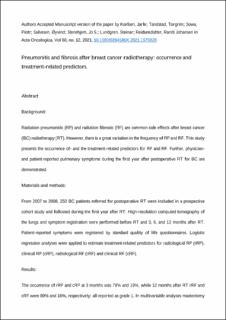| dc.description.abstract | Background Radiation pneumonitis (RP) and radiation fibrosis (RF) are common side effects after breast cancer (BC) radiotherapy (RT). However, there is a great variation in the frequency of RP and RF. This study presents the occurrence of- and the treatment-related predictors for RP and RF. Further, physician- and patient-reported pulmonary symptoms during the first year after postoperative RT for BC are demonstrated. Materials and methods From 2007 to 2008, 250 BC patients referred for postoperative RT were included in a prospective cohort study and followed during the first year after RT. High-resolution computed tomography of the lungs and symptom registration were performed before RT and 3, 6, and 12 months after RT. Patient-reported symptoms were registered by standard quality of life questionnaires. Logistic regression analyses were applied to estimate treatment-related predictors for radiological RP (rRP), clinical RP (cRP), radiological RF (rRF), and clinical RF (cRF). Results The occurrence of rRP and cRP at three months was 78% and 19%, while 12 months after RT rRF and cRF was 89% and 16%, respectively; all reported as grade 1. In multivariable analyses, mastectomy predicted cRP at three months (OR = 2.48, p = .03) and cRF at six months, ipsilateral lung volume receiving 20 Gray or more (V20), V30, and mean lung dose (MLD) predicted rRP at six months (OR = 1.06, p = .0003; OR = 1.10, p = .001; and OR = 1.03, p = .01, respectively). Endocrine treatment predicted cRF at 12 months (OR = 2.48, p = .02). Physicians reported significant more dyspnea at 3 months (p = .003) and patients reported ‘a little dyspnea’ more at 3 and 12 months compared to baseline (p = .007). Conclusion RP and RF are prevalent in the first year after BC radiation. Mastectomy predicted cRP at three months. V20, V30, D25, and MLD predicted rRP at 6 months, and endocrine treatment predicted cRF at 12 months. Patients and physicians reported dyspnea differently. | en_US |
